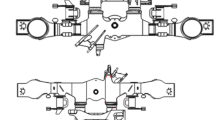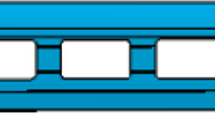Abstract
The traditional fatigue design of accessories attached to a train body does not consider welding residual stress for fatigue life prediction of welded structures during the design stage, thereby resulting in insufficient fatigue strength for local welded parts. The power spectral density of random excitation caused by rail irregularity from American six-level spectrums was obtained in this paper. Through welding thermal elastoplastic theory combined with ellipsoid heat source model, a numerical simulation for welding residual stress production and distribution of a train buffer beam was conducted. In accordance with the coupling stress component, the fatigue performance of a train buffer beam under random loads was evaluated by the AA6082 welded joint S-N curve, whose lifetime did not satisfy design requirements. Then, the surrogate model of a train buffer beam for anti-fatigue optimization design was constructed based on the response surface method. The fatigue life of the optimized train buffer beam increased by two orders with the use of the genetic algorithm to find the optimal solution in global variables.
Similar content being viewed by others
References
K. Deplus, A. Simar, W. V. Haver and B. Meester, Residual stresses in aluminium alloy friction stir welds, International Journal of Advanced Manufacturing Technology, 56 (2011) 493–504.
M. De Giorgi, A. Scialpi, F. W. Panella and L. A. C. De Filippis, Effect of shoulder geometry on residual stress and fatigue properties, Journal of Mechanical Science and Technology, 23 (2009) 26–35.
J. Baumgartner and T. Bruder, Influence of weld geometry and residual stresses on the fatigue strength of longitudinal stiffeners, Weld World, 57 (2013) 841–855.
J. Krebs, M. Kassner and L. Alstom, Influence of welding residual stresses on fatigue design of welded joints and components, Weld in the World, 51 (2007) 54–68.
International Institute of Welding, Fatigue Design of Welded Joints and Components, Abington, Cambridge, UK: Abington Publishing (1996).
Eurocode 9, Design of Aluminum Structures, Part 2: Structures Susceptible to Fatigue, Brussels, Belgium: European Committee for Standardization (1999).
IEC 61373, Railway Applications-rolling Stock Equipmentshock and Vibration Tests, Brussels, Belgium: International Electro-technical Committee for Standardization (2010).
W. Zhang, W. Jiang, X. Zhao and S. T. Tu, Fatigue life of a dissimilar welded joint considering the weld residual stress: Experimental and finite element simulation, International Journal of Fatigue, 10 (2018) 182–190.
D. Wang, H. Zhang, B. Gong and C. Deng, Residual stress effects on fatigue behavior of welded T-joint: A finite fracture mechanics approach, Materials and Design, 91 (2016) 211–217.
X. Wang, Q. Meng and W. Hu, Fatigue life prediction for buttwelded joints considering weld-induced residual stresses and nitial damage, relaxation of residual stress, and elasto-plastic atigue damage, Fatigue & Fracture of Engineering Materials & Structures, 42 (2019) 1373–1386.
J. Hensel, T. Nitschke and K. Dilger, Engineering model for the quantitative consideration of residual stresses in fatigue design of welded components, Weld World, 61 (2017) 997–1002.
N. J. Aghdam, S. Hassanifard, M. M. Ettefagh and A. Nanvayesavojblaghi, Investigating fatigue life effects on the vibraion properties in friction stir spot welding using experimental and finite element modal analysis, Journal of Mechanical Engineering, 60 (2014) 735–741.
Z. Zhang, Y. Liu, T. Chen and W. Fan, Vibration fatigue analysis and experimental study of heavy duty truck rear axle, Transacions of Beijing Institute of Technology, 3 (2018) 267–271 (in Chinese).
L. Li, X. Gu, S. Sun, W. Wang, Z. Wan and P. Qian, Effects of welding residual stresses on the vibration fatigue life of a ship’s shock absorption support, Ocean Engineering, 170 (2018) 237–245.
C. Morgenstern, C. M. Sonsino, A. Hobbacher and F. Sorbo, Fatigue design of aluminium welded joints by the local stress concept with the fictitious notch radius of rf=1 mm, International Journal of Fatigue, 28 (2006) 881–890.
G. E. Carr and M. D. Chapetti, On the detection threshold for atigue cracks in welded steel beams using vibration analysis, International Journal of Fatigue, 33 (2011) 642–648.
S. H. Han, D. G. An, S. J. Kwak and K. W. Kang, Vibration fatigue analysis for multi-point spot-welded joints based on frequency response changes due to fatigue damage accumulation, International Journal of Fatigue, 48 (2013) 170–177.
X Li, D. Shang, J. Zhou and M. Bao, Prediction of fatigue life based on change of natural frequency and load characteristic or spot welded joint, Transactions of the China Welding Institution, 5 (2010) 85–89 (in Chinese).
T. Zhu, S. Xiao, G. Yang and J. Liu, Study on fatigue life in frequency domain for bogie frame, Journal of Mechanical Strength, 1 (2016) 160–166 (in Chinese).
C. Li, Study on welding stress field of aluminum alloy based on numerical simulation, Master Thesis, Hunan University, Changsha, China (2013) 11–40 (in Chinese).
Z. Q. Gu, C. J. Mi, Z. P. Ding, Y. Zhang, S. C. Liu and D. Z. Nie, An energy-based fatigue life prediction of a mining truck welded frame, Journal of Mechanical Science and Technology, 30 (9) (2019) 3615–3624.
GB/T 3015-2008, Metallic Materials-fatigue Testing-axialforce-controlled Method (in Chinese).
S. Zhang, The characteristics analysis and optimization of heavy duty mining dump truck vibration reduction system based on interval method, Ph.D. Thesis, Hunan University, Changsha, China (2019) 100–125 (in Chinese).
A. Ariyarit, M. Sugiura, Y. Tanabe and M. Kanazaki, Hybrid surrogate-model-based multi-fidelity efficient global optimization applied to helicopter blasé design, Engineering Optimization, 50 (6) (2018) 1016–1040.
A. Ariyarit and M. Kanazaki, Multi-fidelity multi-objective efficient global optimization applied to airfoil design problems, Applied Sciences, 7 (12) (2017) 1–21.
Acknowledgments
The authors would like to express their gratitude for the support of the Excellent Youth Project of Hunan Education Department (Grant No. 18B031), the Postgraduate Research Innovation Project of the Human Education Department (Grant No. CX20190846), and the National Natural Science Foundation of China (Grant No. 51975192).
Author information
Authors and Affiliations
Corresponding author
Additional information
Recommended by Editor Chongdu Cho
Mi Chengji is a lecturer at the School of Mechanical Engineering, Hunan University of Technology. He completed his Ph.D. at the State Key Laboratory of Advanced Design and Manufacture for Vehicle Body (Hunan University). His research interests include structural fatigue life estimation and optimization.
Rights and permissions
About this article
Cite this article
Mi, C., Liu, J., Xiao, X. et al. Random vibration fatigue life assessment and optimization of a train buffer beam considering welding residual stress. J Mech Sci Technol 34, 1071–1080 (2020). https://doi.org/10.1007/s12206-020-0116-5
Received:
Revised:
Accepted:
Published:
Issue Date:
DOI: https://doi.org/10.1007/s12206-020-0116-5




